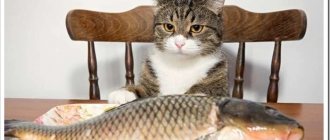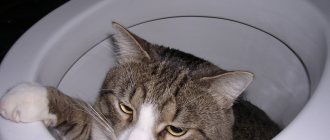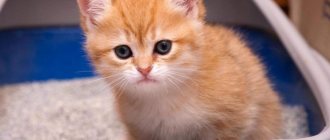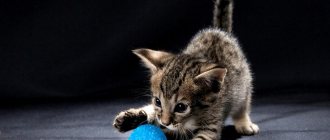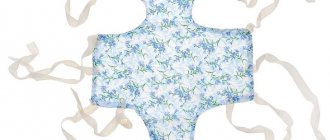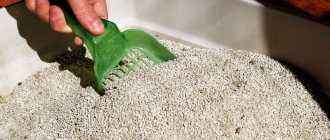The curiosity and active lifestyle of domestic cats often play a cruel joke on them, causing a foreign object to enter the gastrointestinal tract. The owner of a furry fidget must know not only the symptoms of the disease, but also what to do in such a situation, what danger a foreign object poses in the animal’s body. Often, in order to save the life of a pet, a veterinarian has to resort to surgery.
Why does a cat swallow objects?
Experienced breeders and veterinarians know that most often the penetration of foreign bodies occurs through the digestive tract. Curious cats, playing with various objects that come into their field of vision, often swallow them. Especially often, during the operation, veterinarians discover caps from valerian, parts of children's construction sets, coins, construction waste, and burst balloons.
The peak of calls regarding animals swallowing a foreign object usually occurs during the New Year holidays. Bright tinsel, small Christmas tree decorations, parts of garlands, and Christmas tree decorations attract the attention of curious cats with their shine and rustle.
Furry couch potatoes are partial to handicraft items (threads, needles, buttons, decorative elements) and fishing gear (line, hooks, spoons, wobblers, etc.).
The risk group includes small kittens and young animals. Due to natural curiosity and lack of life experience, young animals try new objects and often swallow them. Animals left to their own devices for a long time are also at risk. A bored cat tries to entertain itself by playing with foreign objects. Veterinarians also consider hair balls in a cat's stomach to be a dangerous foreign body.
We recommend reading about how to cure a cat’s runny nose and sneeze at home. You will learn about the possible causes of sneezing in cats, home treatment methods, and preventive measures. And here is more information about why a cat coughs, as if it was choking.
Preventive measures
For prevention purposes, you should follow the following rules:
- give the animal fish without small bones;
- do not feed chicken bones;
- use food based on age, for example, buy small dry food for kittens;
- Finely chop the meat for small kittens, do not leave large pieces near them for an adult cat.
Cats, just like people, can choke easily. Their digestive tract is quite thin and easily susceptible to mechanical damage. The pathological condition can be caused by grass, wool, fish products, and small children's toys. If a cat has a bone stuck in its throat, every owner should know what to do and what conditions to observe.
Is a foreign body really dangerous?
A foreign body entering the digestive tract can lead to the following health problems:
- dehydration due to vomiting and the animal’s refusal to drink water;
- pathologies of cardiac activity up to complete cardiac arrest due to penetration of a sharp object through the wall of the stomach into the pericardium;
- violation of the integrity, numerous ruptures and damage to the mucous membrane throughout the gastrointestinal tract when a foreign body moves due to peristalsis;
- ulcerative lesions of the stomach, small and large intestines;
- necrotic processes due to prolonged presence of non-sterile objects in internal organs;
- blockage, intussusception, intestinal obstruction;
- perforation of the walls of internal organs with sharp objects;
- peritonitis with a high mortality rate.
Veterinary specialists, understanding the danger of a pet swallowing an inedible object, strongly recommend that owners closely monitor their pets and have an idea of what clinical signs are typical for this situation.
Preventive measures
For prevention purposes, you should follow the following rules:
- give the animal fish without small bones;
- do not feed chicken bones;
- use food based on age, for example, buy small dry food for kittens;
- Finely chop the meat for small kittens, do not leave large pieces near them for an adult cat.
Cats, just like people, can choke easily. Their digestive tract is quite thin and easily susceptible to mechanical damage. The pathological condition can be caused by grass, wool, fish products, and small children's toys. If a cat has a bone stuck in its throat, every owner should know what to do and what conditions to observe.
Symptoms in a cat
Ingestion of a foreign object does not always occur before the eyes of the owner. The discovery of the loss of one or another item in the room and the inadequate condition of the cat should cause alarm among household members and force them to take a closer look at the presence of the following symptoms in the pet:
- When an inedible object gets stuck in the esophagus, severe salivation is observed.
- When an object is localized in the pharynx, the cat coughs, wheezes, and may experience cyanosis of the tongue and loss of consciousness.
- The animal is anxious, stretches its neck, and makes frequent swallowing movements.
- Constant vomiting, belching. The duration of vomiting can last from several hours to several days, depending on the severity of the damage to the digestive canal and the location of the object.
- Complete lack of appetite, the animal refuses even its favorite treat.
- Pain in the abdomen, accumulation of gases, bloating.
- Lethargic and apathetic state, drowsiness.
- Stool retention, diarrhea, constipation.
- Reducing the amount of feces.
- With chronic obstruction, cachexia develops due to decreased appetite.
- Signs of general intoxication of the body.
Bearing in mind the danger of foreign bodies entering the gastrointestinal tract of a domestic cat, the owner should immediately take the animal to a specialized clinic.
If a cat or dog ate Christmas tree rain (tinsel)
For cats, the most dangerous time of year is winter due to the New Year holidays - the tendency to eat tinsel, rain and other New Year's decorations often results in serious problems for them. <. alt=”the cat ate the tinsel from the Christmas tree” src=”/upload/medialibrary/82a/82a6ded5b9b395aa29bf8c68c4167ef0.jpg” title=”the cat ate the tinsel from the Christmas tree” contentScore=”18882″>
Dogs suffer most from ingesting bones, parts of toys, and pieces of sticks they play with. The most dangerous consequences are caused by the ingestion of sharp objects that can lead to perforation of the gastrointestinal tract, and thin, oblong objects (rags, tinsel, etc.) - they are the most difficult to identify during a physical examination and visualize using instrumental methods, and the symptoms will be no less threatening.
What to do when a cat swallows an object
Veterinary experts strongly recommend that owners who discover that a cat has swallowed a foreign body not take any independent action. Lack of professional skills and knowledge will lead to even more severe consequences for the pet’s health.
For example, you should not give petroleum jelly, which can cause intussusception when a foreign body is in it. Under no circumstances should you induce vomiting if there is a suspicion that a sharp object, alkali or petroleum product has been swallowed.
The owner must ensure that the animal does not take food or water before visiting the veterinarian, provide the cat with complete rest and urgently take it to a specialized clinic.
Diagnostics in a veterinary clinic
After taking a history and physical examination, the veterinarian begins special examination methods to visualize the foreign object. The following diagnostics are used in veterinary practice:
- Survey radiography of the abdominal organs. It is carried out in two projections: direct and lateral. For a more detailed study, radiography is carried out in a vertical and horizontal position of the furry patient. The method allows you to determine the presence and location of radiopaque objects (metal needles, paper clips, etc.).
On the radiograph: a penny in the intestines of a cat
- To visualize foreign objects such as plastic, threads, a radiopaque substance is used, which is injected into the animal’s body.
- Ultrasound examination of the digestive canal and organs of the thoracic and abdominal cavity. The method allows you to detect intestinal obstruction and determine the state of intestinal motility.
- Using a fiber optic fiberscope, your pet will undergo an endoscopic examination of the esophagus and stomach in a specialized institution. The method is effective if no more than 3-4 hours have passed since the foreign body was swallowed.
Laboratory methods for examining blood and urine are of an auxiliary nature and are necessary for the differential diagnosis of intestinal obstruction due to an infectious disease, intoxication, etc.
Recovery
The veterinarian should continually monitor for any underlying conditions to monitor progress. If your cat has had surgery, it is necessary to wear an Elizabethan cone to prevent the cat from biting through the stitches.
It is important to follow your veterinarian's nutritional instructions to ensure your cat no longer turns to non-food items. Removing stressors, such as other animals and small children, from the cat's environment can help reduce the cat's stress levels. Providing daily mental and physical stimulation can help keep cats that eat items out of boredom from eating again.
Removal by operation
You can preserve the health, and sometimes even the life, of your beloved pet if it swallows foreign objects with the help of surgical intervention performed by an experienced veterinarian.
From the intestines
When intestinal obstruction is confirmed by radiographic and ultrasound methods, the surgeon, as a rule, decides to perform diagnostic laparoscopy. During the operation, the foreign body is removed and the intussusception is reduced. If necessary (in cases of necrosis), part of the intestine is resected.
To learn how to remove a foreign object from a cat’s intestines using enterotomy, watch this video:
From the stomach
In rare cases, it is possible to remove a foreign object from the stomach using diagnostic gastroscopy. If a foreign body is detected in the stomach of a domestic cat using endoscopic, x-ray or ultrasound examination, the surgeon usually decides to perform a gastrotomy.
Removal of threads from the stomach during gastrotomy
Having gained immediate access, the stomach is held in place using ligatures. The foreign body is removed using instruments or palpation. After suturing the mucous membrane and muscle layers, the organ is returned to its anatomical location. The operation is performed under general anesthesia.
From the esophagus
If the location of the foreign body is the esophagus, in some situations it is possible to remove it using an endoscope. If the object is large, the surgeon can perform an esophagotomy. The operation is indicated if the x-ray shows perforation of the walls of the esophagus, or the foreign body is large and has sharp edges.
Often the veterinarian resorts to the following manipulation. Using an endoscope, an object is pushed into the stomach, after which the animal undergoes a gastrotomy, followed by removal of the foreign body.
Removing a foreign body (needle and thread) using an endoscope.
After laparotomy, gastrotomy or esophagotomy, the animal is prescribed a 24-hour fasting diet. Subsequently, the operated pet receives liquid food in small portions. Weakened and dehydrated animals must undergo infusion therapy. To prevent peritonitis and postoperative complications, a course of antibacterial drugs is prescribed.
In complicated cases, the pet is left after surgery for 2-3 days in a specialized institution, using parenteral nutrition. A follow-up ultrasound examination is required after surgery.
We recommend reading about why a cat has bloody stool. You will learn about the reasons for the appearance of blood in the stool, the actions of the owners before going to the veterinary clinic, diagnosis and treatment. And here is more information about how to give an enema to a cat.
Causes
Although cats may eat a foreign object simply out of curiosity or due to their nature, such as mothers who eat their kittens' feces to care for them, there are medical conditions that can cause pica or coprophagia. These reasons include:
- Intestinal parasites
- Diabetes
- Increased hunger
- Malnutrition
- Vitamin deficiency
- Inflammatory bowel disease
- Severe anemia
- Neurological disease
- Thyroid disease
- Stressful environment
- Boredom
Prevention
Knowing about the serious consequences and threat to life when swallowing foreign objects, the owner must strictly follow the following recommendations of veterinary specialists:
- keep the room in which your furry pet lives clean;
- there should be no small items on the floor or within the reach of the animal;
- the feed must be checked for the presence of foreign impurities;
- It is unacceptable to feed a cat bones;
- Toys for your pet should be soft and large in size.
Penetration of a foreign body into the digestive canal of a pet is a dangerous phenomenon for health and life. The animal must be urgently taken to a specialized facility for special diagnostic procedures to visualize the swallowed item. As a rule, treatment comes down to surgical removal of the foreign body by laparoscopy, gastrotomy or esophagotomy, depending on its location.
Similar articles
- Foreign body.
This is not a harmless reason often... In addition to sneezing, the animal experiences shortness of breath, the cat often sleeps with its mouth open. Foreign body. This not harmless reason is often the cause of sneezing in a cat. Read more - How to give an enema to a cat correctly, is it possible to perform...
The animal stops licking itself and avoids communication. Touching the belly causes anxiety in the cat. ... traumatic injuries to the anus and intestines, including the entry of foreign bodies Read more
- Foreign body. Swallowing sharp objects...
Therefore, if a cat has blood in its stool, this indicates that the pet’s health is not in order. ... If the cause of the symptoms is a foreign body, polyps, malignant formations, then the pet can help... Read more
- How to treat a cat’s wound (open, purulent) after...
After the damaged surface is free of debris, dirt and foreign bodies, it is necessary to begin antiseptic treatment. What to use to treat an open wound on a cat... Read more
- Treatment of otitis media in cats: symptoms of purulent and fungal...
Injuries, foreign bodies entering the ear canal. ... Symptoms of otitis media in a cat. Inflammatory phenomena in the ear canal have characteristic features that cannot escape the attention of an observant owner Read more
Ultrasonography
An additional diagnostic method is ultrasound examination (US). It will help determine the presence of indirect signs of the presence of a foreign body: inflammation of the intestinal wall, the presence of gases in the stomach or intestines, lack of contraction of the walls or the so-called “pendulum peristalsis”.
Sometimes the foreign object itself can be noticeable on an ultrasound: objects in the digestive tract emit echoacoustic shadows, metal objects create a strong reverberation effect, soft foreign bodies are visible as hypoechoic formations.
